LST2LBA Law of Business Association: Partnership Analysis Report
VerifiedAdded on 2022/09/02
|5
|999
|8
Report
AI Summary
This report analyzes a legal scenario involving Alfred, Beatrice, and Coco to determine if a partnership exists between them. The analysis focuses on the Partnership Act of 1958 and relevant case law, particularly Ferguson vs. Federal Commissioner of Taxation and Keith Murphy Pty Ltd vs. Custom Credit Corporation Ltd. The report examines whether Coco's financial contribution, involvement in business decisions, and profit-sharing arrangement establish her as a partner rather than a creditor. The analysis applies the essential elements of a partnership, including the intention to carry on business, common intention to make a profit, and profit sharing, to the facts of the case. The conclusion asserts that a partnership does exist among the three individuals, based on the satisfaction of the major rules and essential elements of a partnership as defined by the law.
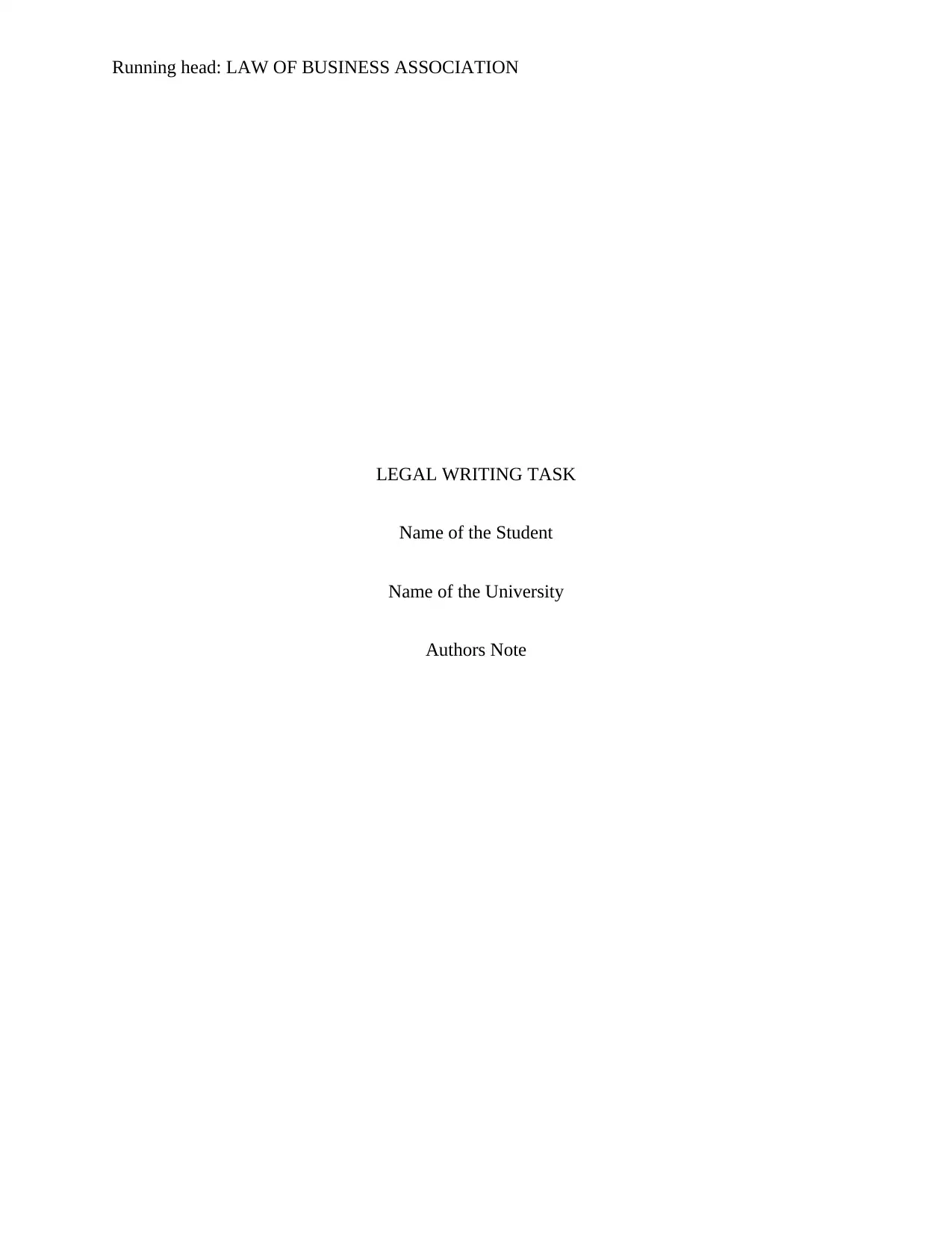
Running head: LAW OF BUSINESS ASSOCIATION
LEGAL WRITING TASK
Name of the Student
Name of the University
Authors Note
LEGAL WRITING TASK
Name of the Student
Name of the University
Authors Note
Paraphrase This Document
Need a fresh take? Get an instant paraphrase of this document with our AI Paraphraser
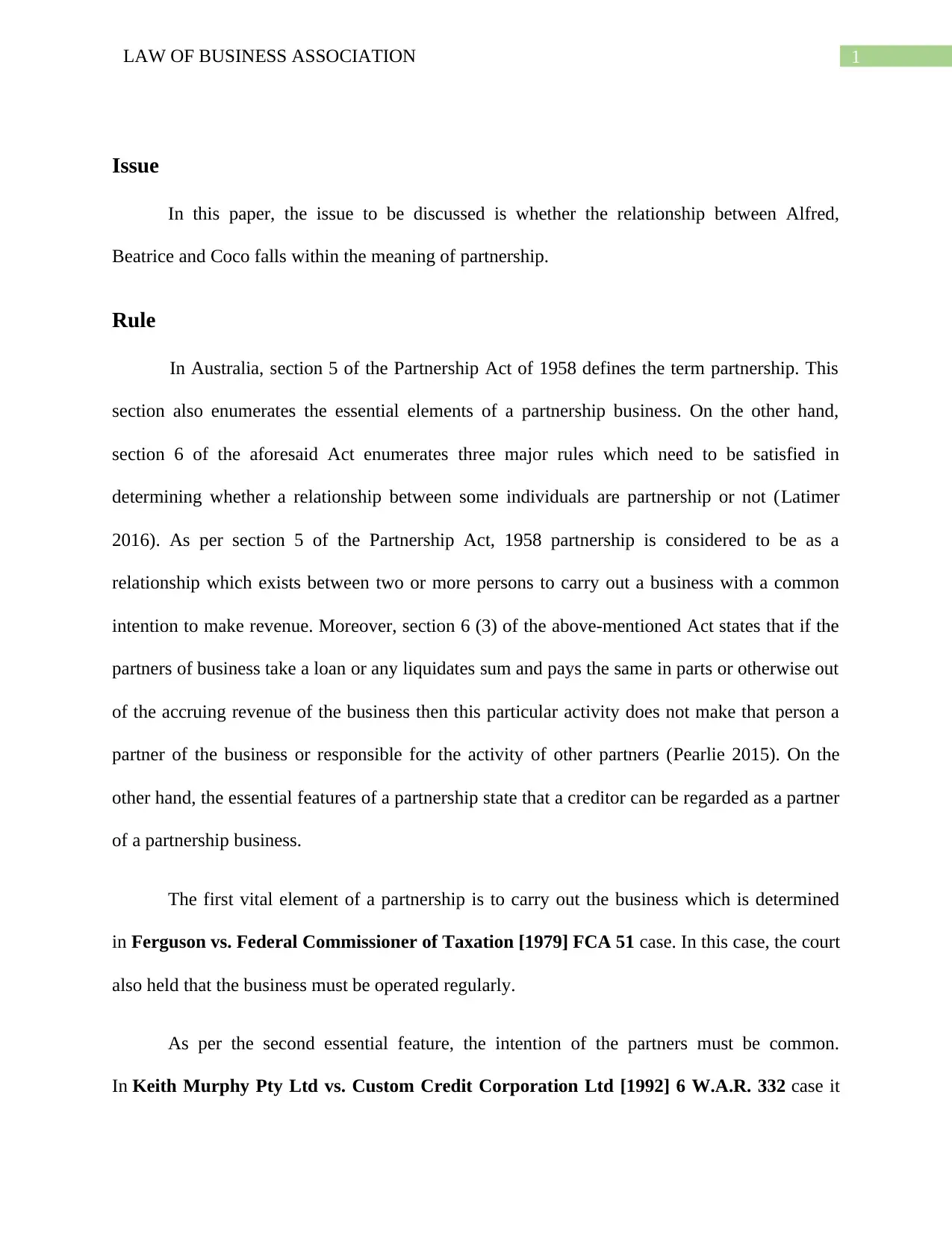
1LAW OF BUSINESS ASSOCIATION
Issue
In this paper, the issue to be discussed is whether the relationship between Alfred,
Beatrice and Coco falls within the meaning of partnership.
Rule
In Australia, section 5 of the Partnership Act of 1958 defines the term partnership. This
section also enumerates the essential elements of a partnership business. On the other hand,
section 6 of the aforesaid Act enumerates three major rules which need to be satisfied in
determining whether a relationship between some individuals are partnership or not (Latimer
2016). As per section 5 of the Partnership Act, 1958 partnership is considered to be as a
relationship which exists between two or more persons to carry out a business with a common
intention to make revenue. Moreover, section 6 (3) of the above-mentioned Act states that if the
partners of business take a loan or any liquidates sum and pays the same in parts or otherwise out
of the accruing revenue of the business then this particular activity does not make that person a
partner of the business or responsible for the activity of other partners (Pearlie 2015). On the
other hand, the essential features of a partnership state that a creditor can be regarded as a partner
of a partnership business.
The first vital element of a partnership is to carry out the business which is determined
in Ferguson vs. Federal Commissioner of Taxation [1979] FCA 51 case. In this case, the court
also held that the business must be operated regularly.
As per the second essential feature, the intention of the partners must be common.
In Keith Murphy Pty Ltd vs. Custom Credit Corporation Ltd [1992] 6 W.A.R. 332 case it
Issue
In this paper, the issue to be discussed is whether the relationship between Alfred,
Beatrice and Coco falls within the meaning of partnership.
Rule
In Australia, section 5 of the Partnership Act of 1958 defines the term partnership. This
section also enumerates the essential elements of a partnership business. On the other hand,
section 6 of the aforesaid Act enumerates three major rules which need to be satisfied in
determining whether a relationship between some individuals are partnership or not (Latimer
2016). As per section 5 of the Partnership Act, 1958 partnership is considered to be as a
relationship which exists between two or more persons to carry out a business with a common
intention to make revenue. Moreover, section 6 (3) of the above-mentioned Act states that if the
partners of business take a loan or any liquidates sum and pays the same in parts or otherwise out
of the accruing revenue of the business then this particular activity does not make that person a
partner of the business or responsible for the activity of other partners (Pearlie 2015). On the
other hand, the essential features of a partnership state that a creditor can be regarded as a partner
of a partnership business.
The first vital element of a partnership is to carry out the business which is determined
in Ferguson vs. Federal Commissioner of Taxation [1979] FCA 51 case. In this case, the court
also held that the business must be operated regularly.
As per the second essential feature, the intention of the partners must be common.
In Keith Murphy Pty Ltd vs. Custom Credit Corporation Ltd [1992] 6 W.A.R. 332 case it
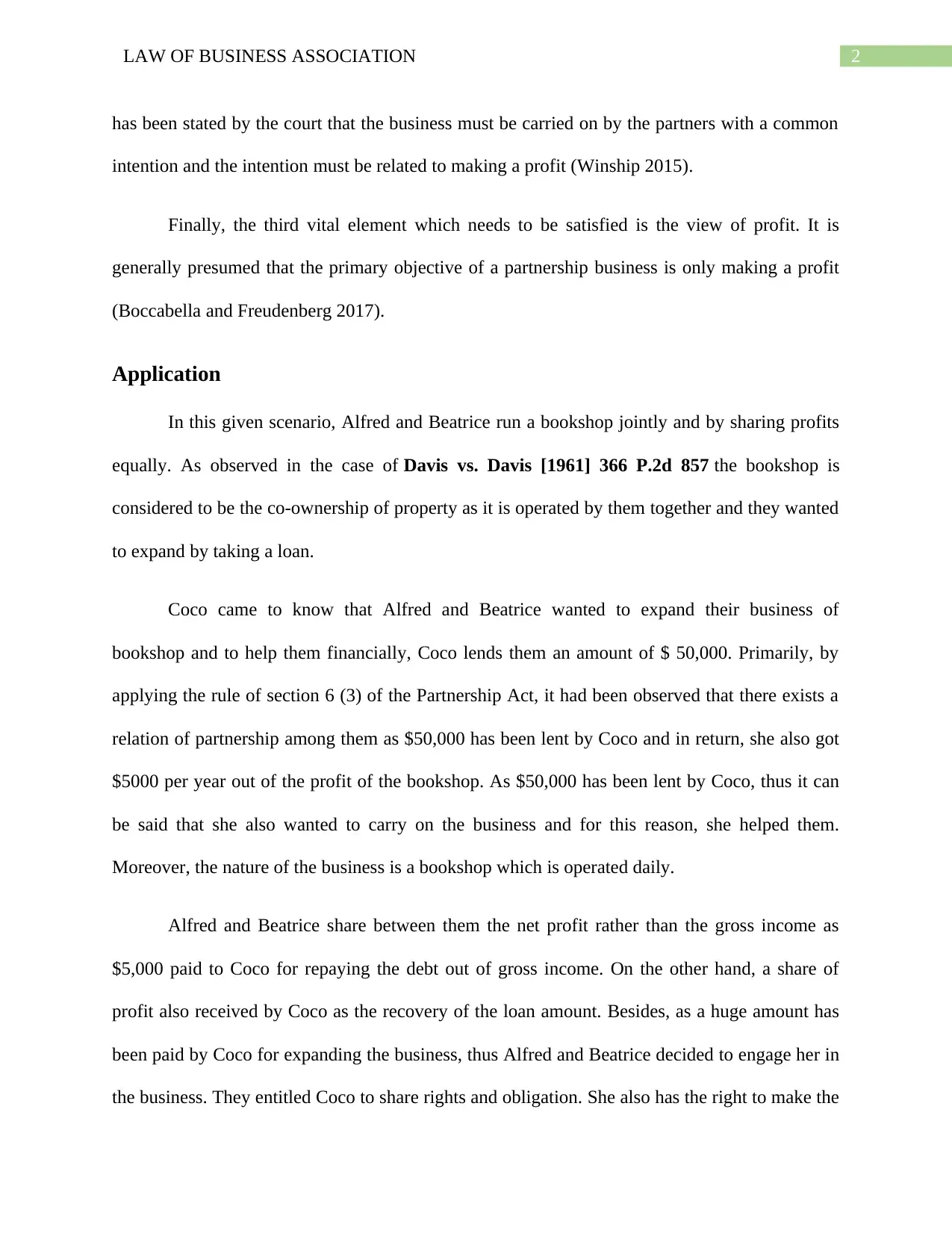
2LAW OF BUSINESS ASSOCIATION
has been stated by the court that the business must be carried on by the partners with a common
intention and the intention must be related to making a profit (Winship 2015).
Finally, the third vital element which needs to be satisfied is the view of profit. It is
generally presumed that the primary objective of a partnership business is only making a profit
(Boccabella and Freudenberg 2017).
Application
In this given scenario, Alfred and Beatrice run a bookshop jointly and by sharing profits
equally. As observed in the case of Davis vs. Davis [1961] 366 P.2d 857 the bookshop is
considered to be the co-ownership of property as it is operated by them together and they wanted
to expand by taking a loan.
Coco came to know that Alfred and Beatrice wanted to expand their business of
bookshop and to help them financially, Coco lends them an amount of $ 50,000. Primarily, by
applying the rule of section 6 (3) of the Partnership Act, it had been observed that there exists a
relation of partnership among them as $50,000 has been lent by Coco and in return, she also got
$5000 per year out of the profit of the bookshop. As $50,000 has been lent by Coco, thus it can
be said that she also wanted to carry on the business and for this reason, she helped them.
Moreover, the nature of the business is a bookshop which is operated daily.
Alfred and Beatrice share between them the net profit rather than the gross income as
$5,000 paid to Coco for repaying the debt out of gross income. On the other hand, a share of
profit also received by Coco as the recovery of the loan amount. Besides, as a huge amount has
been paid by Coco for expanding the business, thus Alfred and Beatrice decided to engage her in
the business. They entitled Coco to share rights and obligation. She also has the right to make the
has been stated by the court that the business must be carried on by the partners with a common
intention and the intention must be related to making a profit (Winship 2015).
Finally, the third vital element which needs to be satisfied is the view of profit. It is
generally presumed that the primary objective of a partnership business is only making a profit
(Boccabella and Freudenberg 2017).
Application
In this given scenario, Alfred and Beatrice run a bookshop jointly and by sharing profits
equally. As observed in the case of Davis vs. Davis [1961] 366 P.2d 857 the bookshop is
considered to be the co-ownership of property as it is operated by them together and they wanted
to expand by taking a loan.
Coco came to know that Alfred and Beatrice wanted to expand their business of
bookshop and to help them financially, Coco lends them an amount of $ 50,000. Primarily, by
applying the rule of section 6 (3) of the Partnership Act, it had been observed that there exists a
relation of partnership among them as $50,000 has been lent by Coco and in return, she also got
$5000 per year out of the profit of the bookshop. As $50,000 has been lent by Coco, thus it can
be said that she also wanted to carry on the business and for this reason, she helped them.
Moreover, the nature of the business is a bookshop which is operated daily.
Alfred and Beatrice share between them the net profit rather than the gross income as
$5,000 paid to Coco for repaying the debt out of gross income. On the other hand, a share of
profit also received by Coco as the recovery of the loan amount. Besides, as a huge amount has
been paid by Coco for expanding the business, thus Alfred and Beatrice decided to engage her in
the business. They entitled Coco to share rights and obligation. She also has the right to make the
⊘ This is a preview!⊘
Do you want full access?
Subscribe today to unlock all pages.

Trusted by 1+ million students worldwide
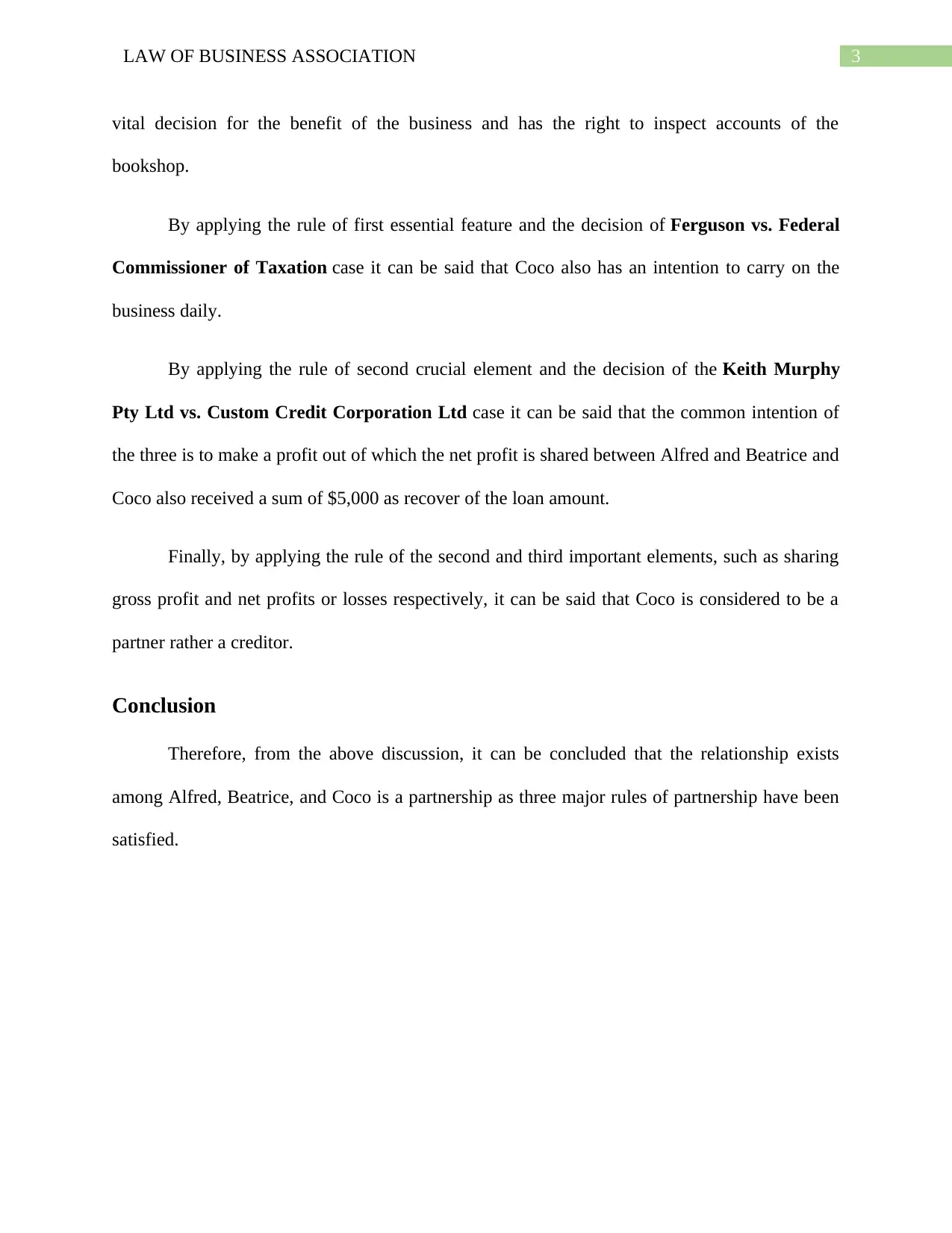
3LAW OF BUSINESS ASSOCIATION
vital decision for the benefit of the business and has the right to inspect accounts of the
bookshop.
By applying the rule of first essential feature and the decision of Ferguson vs. Federal
Commissioner of Taxation case it can be said that Coco also has an intention to carry on the
business daily.
By applying the rule of second crucial element and the decision of the Keith Murphy
Pty Ltd vs. Custom Credit Corporation Ltd case it can be said that the common intention of
the three is to make a profit out of which the net profit is shared between Alfred and Beatrice and
Coco also received a sum of $5,000 as recover of the loan amount.
Finally, by applying the rule of the second and third important elements, such as sharing
gross profit and net profits or losses respectively, it can be said that Coco is considered to be a
partner rather a creditor.
Conclusion
Therefore, from the above discussion, it can be concluded that the relationship exists
among Alfred, Beatrice, and Coco is a partnership as three major rules of partnership have been
satisfied.
vital decision for the benefit of the business and has the right to inspect accounts of the
bookshop.
By applying the rule of first essential feature and the decision of Ferguson vs. Federal
Commissioner of Taxation case it can be said that Coco also has an intention to carry on the
business daily.
By applying the rule of second crucial element and the decision of the Keith Murphy
Pty Ltd vs. Custom Credit Corporation Ltd case it can be said that the common intention of
the three is to make a profit out of which the net profit is shared between Alfred and Beatrice and
Coco also received a sum of $5,000 as recover of the loan amount.
Finally, by applying the rule of the second and third important elements, such as sharing
gross profit and net profits or losses respectively, it can be said that Coco is considered to be a
partner rather a creditor.
Conclusion
Therefore, from the above discussion, it can be concluded that the relationship exists
among Alfred, Beatrice, and Coco is a partnership as three major rules of partnership have been
satisfied.
Paraphrase This Document
Need a fresh take? Get an instant paraphrase of this document with our AI Paraphraser
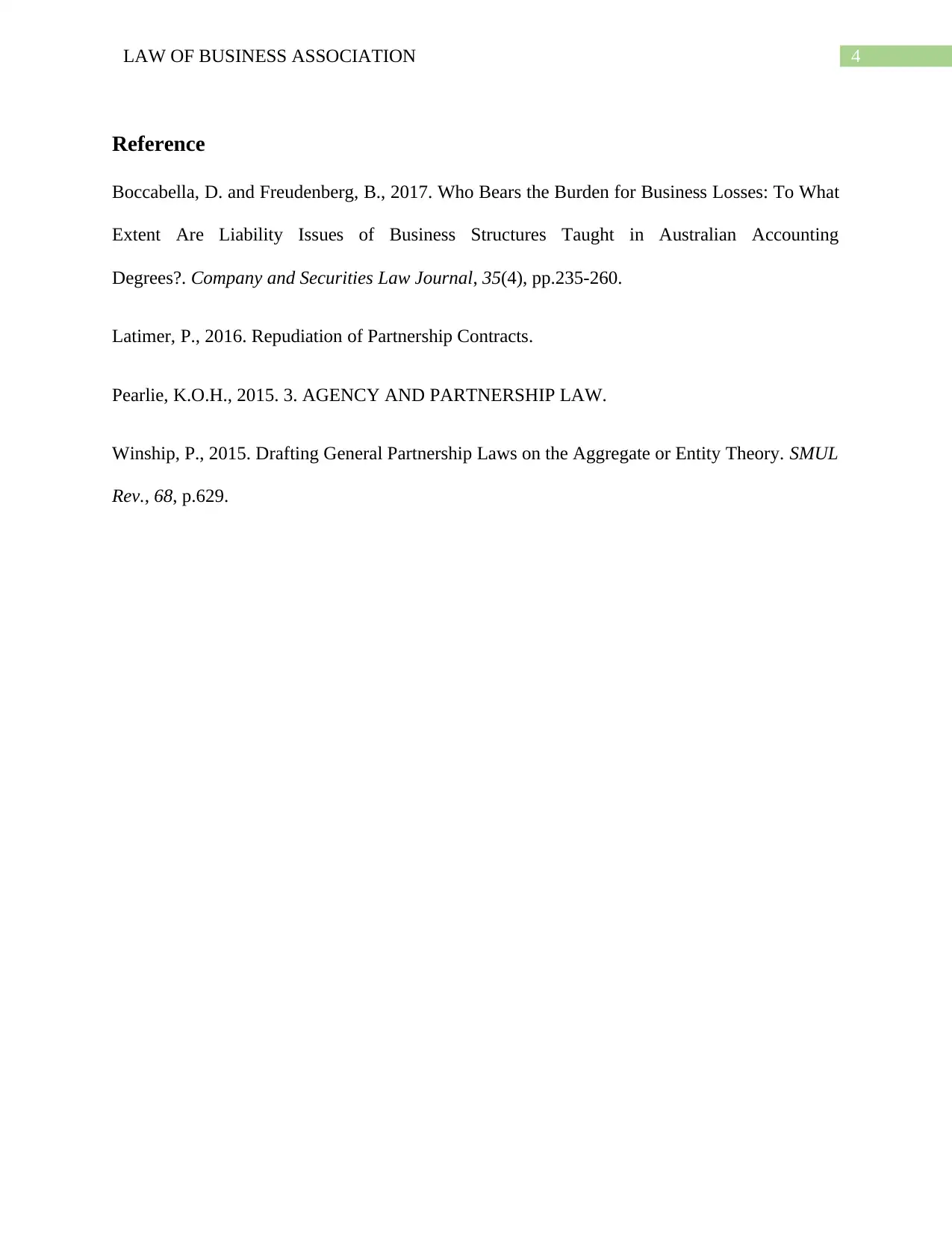
4LAW OF BUSINESS ASSOCIATION
Reference
Boccabella, D. and Freudenberg, B., 2017. Who Bears the Burden for Business Losses: To What
Extent Are Liability Issues of Business Structures Taught in Australian Accounting
Degrees?. Company and Securities Law Journal, 35(4), pp.235-260.
Latimer, P., 2016. Repudiation of Partnership Contracts.
Pearlie, K.O.H., 2015. 3. AGENCY AND PARTNERSHIP LAW.
Winship, P., 2015. Drafting General Partnership Laws on the Aggregate or Entity Theory. SMUL
Rev., 68, p.629.
Reference
Boccabella, D. and Freudenberg, B., 2017. Who Bears the Burden for Business Losses: To What
Extent Are Liability Issues of Business Structures Taught in Australian Accounting
Degrees?. Company and Securities Law Journal, 35(4), pp.235-260.
Latimer, P., 2016. Repudiation of Partnership Contracts.
Pearlie, K.O.H., 2015. 3. AGENCY AND PARTNERSHIP LAW.
Winship, P., 2015. Drafting General Partnership Laws on the Aggregate or Entity Theory. SMUL
Rev., 68, p.629.
1 out of 5
Related Documents
Your All-in-One AI-Powered Toolkit for Academic Success.
+13062052269
info@desklib.com
Available 24*7 on WhatsApp / Email
![[object Object]](/_next/static/media/star-bottom.7253800d.svg)
Unlock your academic potential
Copyright © 2020–2025 A2Z Services. All Rights Reserved. Developed and managed by ZUCOL.





